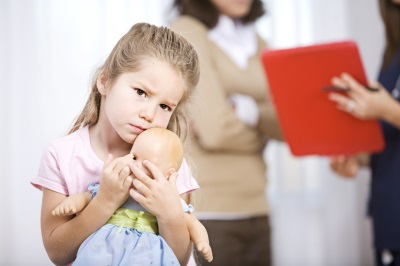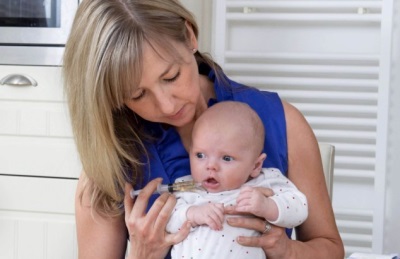Signs and treatment of rotavirus infection in children
Rotavirus infection, which is also called rotavirosis, occurs in almost all children. But in order for the disease to pass relatively easily and not cause complications, it should be able to recognize and heal properly.
What is dangerous disease?
The disease is especially dangerous for young children (up to 2 years), because it quickly leads to dehydration, and young children are very sensitive to the loss of water and electrolytes. In infants with rotavirus infection with severe diarrhea and frequent vomiting, the functioning of the internal organs is disturbed after a few hours, which can be deadly. If treatment is started on time and carried out correctly, in most cases the infection does not lead to serious consequences.
Parents should immediately seek medical help if:
- The child is lethargic and sleepy, constantly sleeping.
- When crying he does not flow tears.
- The lips of the baby are dry.
- Baby's skin is loose.
- The kid refuses to drink.
- All that the child drinks, comes back with vomiting.
- Blood appeared in the baby’s stool.
Signs and symptoms
The main signs of the disease in childhood are:
- Stool disorder - feces are very frequent, in a large volume, watery, there are no blood impurities in the stool.
- Increased body temperature.
- Nausea and vomiting, and abdominal pain.
- Great weakness.
Older children with rotavirus infection may not have vomiting or fever.
What is the temperature usually in a child?
In most children, body temperature increases slightly - up to 38 degrees. However, there is an increase in temperature to 39-39.5 degrees. In this case, the child is given drugs that lower the temperature to a normal level.
Is it possible to distinguish from food poisoning?
The symptoms of rotavirus infection and food poisoning are similar, and both problems can occur in several people at once. That is why in the first days to answer exactly, it is a poisoning or an infection, it does not work.
If after 2-3 days the child became better, then, most likely, he had food poisoning. If the symptoms remain, this indicates rotavirus infection. To more accurately identify the causes should be done stool tests.
How is the disease transmitted?
Rotavirus is spread through dishes, food, water and other items that could become contaminated with particles of feces from people who already have an infection. Very often, such a virus causes an epidemic in winter and spring. The pathogen virus is resistant to cold and chlorination.
Incubation period
The duration of the incubation period for this infection is usually two or three days, but can last from one to five days. During this period, the virus enters the intestine and begins to develop there, causing diarrhea.
How long does the disease last and how many days is it contagious?
Frequent stool worries a sick child, on average, from 5 to 7 days. Most children feel normal after 7-10 days from the first manifestations of the infection.
Children begin to excrete viruses with feces even before the first clinical manifestations of the infection. Baby is contagious within ten days after the first symptoms of the disease. A person is most infectious during severe diarrhea and vomiting.
Quarantine for sick children is usually prescribed for 10 days after the first symptoms of rotavirosis. At this time, the patient should be isolated from infants, which did not do. rotavirus vaccination.
Possible consequences and complications
Special complications, if the rotavirus infection began to heal immediately, is not observed. It is very important to ensure that the child does not suffer from dehydration, as well as to bring down too high a temperature. The overall prognosis for this infection is favorable.
If you miss the time and allow severe dehydration of the baby, there may be serious problems with the work of the child’s internal organs, as well as an increased risk of death.
Diagnostics and analyzes
To make sure that the child really has rotavirosis, he can be given a stool test, in which antigens are released in the stool. Feces are examined by ELISA and PCR, detecting virus particles.
Opinion E. Komarovsky
The famous pediatrician reminds that in the first-aid kit of each family with a small child there must be drugs used for rehydration. They are diluted with water and given to babies with diarrhea or vomiting. These funds are simply indispensable in the case of rotavirus infection.
At the same time, Komarovsky draws the attention of parents to what they call rotavirus infection intestinal flu is incorrect. Since influenza viruses develop only in the respiratory tract and do not infect the intestines, rotavirus cannot be associated with influenza and is an intestinal infection.
Treatment
There are no special drugs that are prescribed specifically for rotavirus infection, so the treatment is symptomatic.
The most important
Since the most dangerous action of rotavirus is rapid dehydration, it is most important, from the first signs of the disease, to ensure adequate fluid intake in the child’s body. And the best way to give your baby liquid and salt is to water the crumbs with special pharmacy salt solutions. Diet for rotavirus infection described in detail in our other article.
It may not be easy for babies to give these medicines. Try to pour a few milliliters of liquid into the baby’s mouth from a syringe without a needle. If you don’t give the baby a saline solution, then call an ambulance immediately.
Can I give money for diarrhea and vomiting?
Studies have determined that such drugs help reduce dehydration and facilitate the progress of the disease, but their use is allowed only for children who have already turned 6 months. In addition, it is best to give such drugs after consulting a doctor.
Should I be treated with antiviral drugs or antibiotics?
With this pathology, the need to take antibiotics or antiviral no medication.
We encourage you to read an article about how not to get rotavirus infection.












